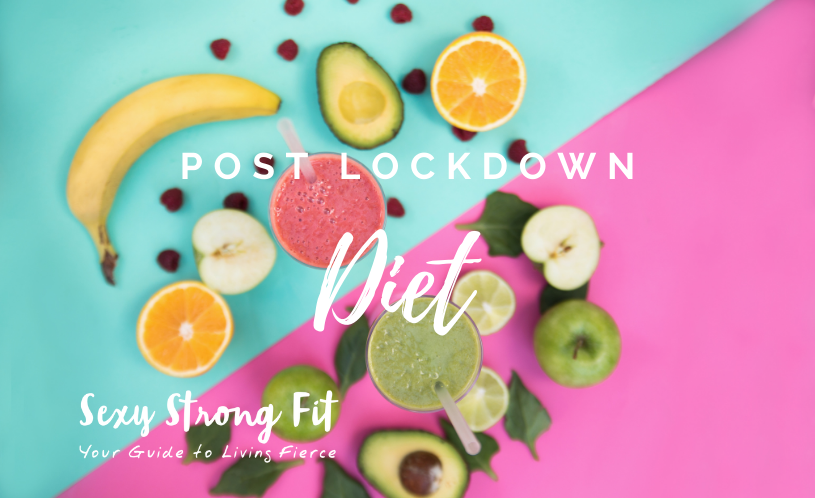Need a post lockdown diet to keep your immune system optimized and shed those extra pounds? When the pandemic is over, it doesn’t mean you should stop eating healthy. Hopefully, you learned something about your diet and your health this past year! It’s critical that your post lockdown diet helps keep your calories and cravings in check and prevents you from overeating. Want to stay healthy and get rid of the quarantine 15, keep reading!
Here’s Four Tips For Your Post Lockdown Diet:
Tip #1: Include Food that Helps to Maintain Your Health and Immunity
A healthy post lockdown diet includes a variety of fresh plant foods including vegetables and fruits. Plant foods contain phytonutrients, vitamins, minerals, antioxidants and fiber. Vitamins and minerals help metabolize our foods and build the cells we need to bolster our immune function.
Antioxidants protect our body against cell oxidation or damage that can lead to aging, poor cell function and even disease. While, fibre is important because it helps clean and scrub the gut. Fibre absorbs and packages toxins for removal from the gut, ensuring they’re not absorbed into the blood stream.
A few plant foods worth mentioning – ginger, garlic and turmeric have each been shown to have unique active phyto-compounds that can help boost the immune system. Foods rich in zinc – such as meat, chickpeas, lentils, nuts and seeds are also important. Zinc is involved in many pathways in the body including the immune response. This mineral is an effective and powerful antioxidant.
Be sure to also stock up on vitamin C rich foods like broccoli, kale, grapefruit, lemons, limes and oranges. Vitamin C is important in the development of white blood cells – needed for our immune system function.
Tip #2: Aim to Maintain or Reduce Your Calorie Intake
You likely reduced your calorie needs will being stuck indoors. Even when you start to exercise and move again, if you gained weight, you’ll need to reduce your calorie intake until you’ve lost those extra pounds.
It’s important to plan your post lockdown diet to avoid overeating. Plan your weekly meals. Select a few recipes to try, prep, cook and portion each meal using a digital scale. This will ensure you’re getting healthy, balanced meals, and will avoid the hangries too!
If you want to lose weight faster, you should reduce your carb intake and up your protein intake. Aim for a macronutrient ratio that provides 40% of your calories in protein, 20 to 30% in carbs and the rest in fat. Those ratios can change depending on how much activity you get and how your body metabolizes carbs. Fill your diet with energizing foods including proteins such as chicken, fish, eggs and lean red meat, plenty of plants including any and all vegetables and fruits and healthy fats including nuts, seeds, avocado and olives!
If you’re not sure how much calories you need to maintain or lose weight, you can use an online BMR calculator – which will determine your calories needs based on your weight, height, age and activity level. This will give you a base calorie range to start with, or go here and calculate it yourself!
Tip # 3: Structure Your Post Lockdown Diet to Avoid Overeating
Following a structure not just for your day, but also your diet can make sure you’re not just eating out of boredom. Without the confines of usual daily life, like work, gym workouts, family and social gatherings, it can be easy to let your usual diet and eating times slip.
Structure your day by getting up at the same time you would during a normal work week. Avoid sleeping the day away – however tempting it might be. Have set times for work, reading, learning something new, exercise or activity, as well as when to eat your meals and snacks. Be sure to eat your meals every 3 to 4 hours, throughout the day to help control hunger and keep your blood sugar levels balanced. Aim for 3 meals and 2 snacks per day.
Tip #4: Keep Cravings and Stress Eating in Check
Stress eating can be triggered by anxiety, sadness or even boredom. Stress causes an increase in cortisol, which can inhibit your body from processing carbohydrates and can increase your cravings for sugary foods.
A sign of stress eating is when you reach for food even though you’re not physically hungry. If you find yourself eating every few hours, consider whether that hunger is real, or the result of boredom, stress of the situation or both in this case!
Eating a diet that provides lots of fibre from fruit, vegetables, slow digesting carbs like lentils, chickpeas, nuts and seeds, can help slow down digestion and keep you feeling full for longer. High fibre foods provide a sustained energy release.
Foods that are lower in fibre including: white bread, pastry, white pasta and white rice, or any food that is processed and made from white flour and white sugar, will get digested fast and spike blood glucose levels. This high-energy spike will be followed by an energy low, as the glucose or sugar is cleared from the blood. These energy high and lows can cause more cravings and result in more eating if you’re not careful.
Become more aware of the reasons you’re eating. Instead of reaching for sugary sweets, have a small high protein snack between meals to help control cravings. Consider having a handful of nuts, small Greek yoghurt, a protein shake, or even hummus with veggie sticks.
Until Next Time,
Be Fierce & Rule the World!
Lauren Jacobsen










